 August 2021
The environment, after all, is where we all meet, where we all have a mutual interest. It is one thing that all of us share. It is not only a mirror of ourselves, but a focusing lens on what we can become.
~Lady Bird Johnson
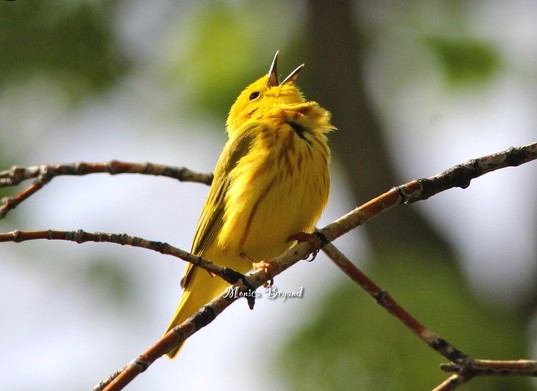 Yellow warbler. PHOTO: Monica Bryand
Long ago, the world was filled with evil. Men and women lost respect for each other. The Creator was unhappy about this and decided to cause a great flood to purify the earth.
A man named Waynaboozhoo survived. He built a raft for the animals and himself, and they floated around waiting for the water to go down. It didn’t. So, Waynaboozhoo asked the strong swimmers to dive down to the Old World to bring mud so he could create a New World.
Several tried and none succeeded until a small coot, Aajigade, gave his life to get the mud. Waynaboozhoo blew life back into Aajigade’s body and announced the little bird would always retain a place of honor.
Waynaboozhoo took the mud in his hands and commanded it to grow. He needed a place to put it as it grew. The snapping turtle, Mikinaak, offered its broad back. "Miigwetch, Mikinaak," said Waynaboozhoo. "From this day on, you shall have the ability to live in all the worlds, under the mud, in the water, and on land."
Waynaboozhoo sent the birds, benishiyag, to fly around to survey the land: "Let me know how the land is doing. Send back your messages with songs." To this day, that is what the birds continue to do.
Excerpt with edits from Beakingoff blog.
 Naturalist programs are back in session! Click on the photo for calendar.
pájaro • shimbir • bird • noog • fagel

Each summer and fall, the shetek visits its namesake lake, headwaters of the Des Moines River, at Lake Shetek State Park
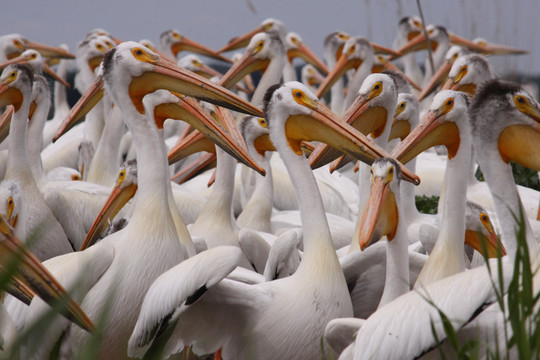 PHOTO: Carrol Henderson
Look for pelicans and shorebirds from the Eastlick Marsh observation deck. Keep your distance and use binoculars or a spotting scope. Pelicans have been known to abandon their eggs and chicks if people get too close.
"Lac qui Parle" is a French translation of the Dakota name for the lake at Lac qui Parle State Park. The "lake that talks" is aptly named for the vocalizations made by birds during their seasonal migration. Nearby Marsh Lake has the state’s largest white pelican colony.
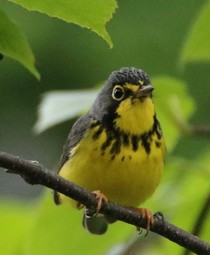
Frontenac State Park is tops for warblers. It provides key nesting habitats for many warbler species, including blue-winged, yellow, cerulean, and prothonotary warblers, American redstarts, ovenbirds, Louisiana waterthrushes, and common yellowthroats.
Look and listen for warblers along Sand Point Trail. Spot gulls, terns, waterfowl, shorebirds and bald eagles when you reach the shore of Lake Pepin.
More about the warblers of Frontenac.
|
Canada warbler. PHOTO: Monica Bryand
"I combine my love for birding with kayaking to get a different perspective, watching birds from shore." ~Monica Bryand
Two species of swans are native to Minnesota — trumpeter and tundra swans. They are similar in appearance, but tundra swans are smaller and have a small yellow notch in the corner of the eye. Also called "whistling swans," tundra swans make a smooth, high-pitched bugle, very different from the loud trumpeting of the trumpeter swan.
Trumpeter swans nest on muskrat houses or beaver lodges in shallow ponds and lakes. They feed on emergent vegetation such as cattails, bulrushes and sedges. Look for trumpeter swans at bdote, where the Minnesota and Mississippi rivers meet. Look for tundra swans feeding farther south on the Mississippi River, between Weaver and Brownsville, Minn. Nearly 50,000 tundra swans stop at Brownsville each fall!
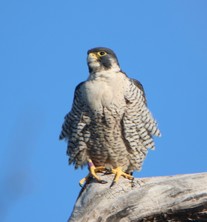
Peregrine falcons disappeared from the Midwest in the 1960s due to widespread use of the pesticide DDT. Minnesota’s first wild-nesting peregrines nested successfully at Tettegouche State Park in 1988. Today, two to three pairs of peregrines nest at Tettegouche most years. Look for them spring through summer on cliff sites along the north shore of Lake Superior.
|
PHOTO: Monica Bryand
 Minnesota Conservation Volunteer (MCV), the Minnesota DNR's print magazine, is dedicated to Minnesota’s wild places and creatures. Below, four of our favorite bird stories from our favorite magazine.
The American white pelican is one of North America’s largest bird species: Its body may be 5 feet long (1.5 meters) and its wingspan up to 9½ feet (almost 3 meters)!
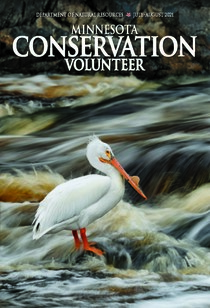
Like all birds, the nose and mouth of pelicans are combined to form the bill. Unlike other birds, the white pelican's bill is up to 13½ inches long (34 centimeters) and pointed like a knight’s broadsword.
Stretchy, loose skin connects the lower half of the pelican’s bill to its slender neck below, forming a pouch. This pouch allows the pelican to scoop up to 3 gallons of water (that's over 11 liters) — along with small fish, salamanders, tadpoles or crayfish that it quickly swallows. In spring, a rounded plate grows on top of the bill. This “horn” indicates the bird is ready to mate.
The rest of the story, in the latest issue of MCV.
|
PHOTO: Stephen Maxson
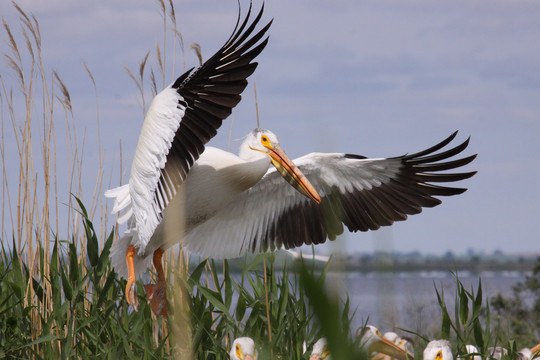 Despite its name, the white pelican isn’t purely white. When it rises into flight, a wide triangle of black feathers is revealed at the tip and lower edge of each wing. The bill and webbed feet are also brightly colored — pumpkin orange during the nesting season, fading to pinkish-yellow in winter. PHOTO: Carrol Henderson
The resonant calls of trumpeter swans are made possible thanks to an extra-long trachea that is, in effect, a nearly 3-foot-long (1 meter) trumpet, stretching from lungs to bill.
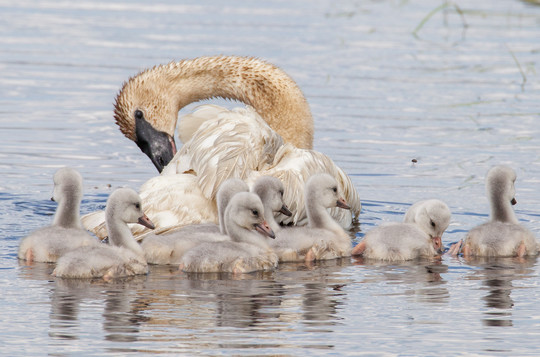 Adult trumpeter swans have snow-white plumage with black legs and a black bill. Juveniles have pearly-gray plumage and pinkish bills in their first year. PHOTO: Travis Novitsky
The trumpeter swans' wingspread can be nearly 8 feet (2.5 meters). PHOTO BELOW: Monica Bryand

Trumpeter swans' large size (can weigh up to 35 pounds or 15.8 kilos), conspicuous white plumage, and thick down contributed to their historic demise. Subsistence use of swans as food by Native Americans would have occurred for thousands of years without diminishing the species. But European fur trappers and settlers hunted swans not only for meat, but also for swanskins and swan's-down. The bird's long wing feathers made popular writing quills. Overhunting completely wiped out Minnesota’s swan population in the late 1800s.
With patience, persistence and optimism, wildlife biologists and volunteers found a way to bring the world's largest waterfowl species back to the state. Read the first-person account of the swan restoration efforts on the MCV.
|
Minnesota is home — at least temporarily each year — to a total of 32 shorebird species, including a variety of sandpipers, plovers and avocets.
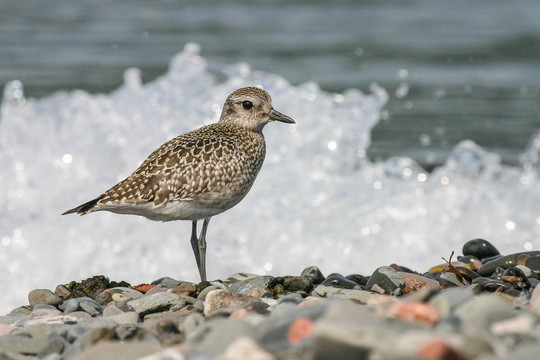 American golden plover. PHOTO: Travis Novitsky
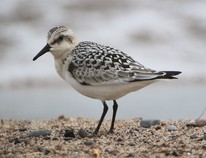
While some of these birds breed here, others seen in the state are present for only a few weeks during migration. As these birds stop to refuel in our state during their long journeys north in the spring and south in the fall, they provide keen observers the opportunity to view their rather strange and even amusing forms.
|
Above, sanderling. Below, greater yellowlegs. PHOTOS: Monica Bryand

Many of these migrating birds face threats to their populations elsewhere along their journeys, from wetland degradation to climate change, that are significantly affecting shorebird populations worldwide. It's important we do our part in Minnesota to ensure these same threats are minimized as the shorebirds complete our leg of the journey, and that begins with learning to recognize and appreciate this remarkable group of birds.
|
The peregrine falcon is the fastest animal on Earth and feeds exclusively on birds.
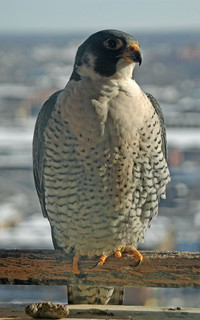
In 1994, a spirited male peregrine named Sota hatched in a nest box atop the Mayo Clinic in Rochester, Minn. The falcon fledged that summer before reappearing four years later in downtown St. Paul. When ornithologist Harrison "Bud" Tordoff confirmed the falcon's identity, he noticed Sota had two toes on each foot that appeared to be half frostbitten off.
"For a predatory bird such as a peregrine, this injury could be fatal. Not for Sota!" says falconer Jackie Fallon. Sota successfully nested for 15 years, producing 35 young, and lived until the ripe old age of nearly 19. He stayed in Minnesota every winter rather than migrating.
The falcon lives on today as a symbol of the success of the state's decades-long peregrine restoration program.
|
Sota perched on the Bremer Bank building in St. Paul. PHOTO: Jackie Fallon

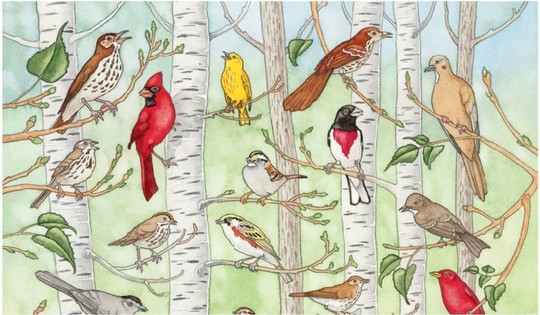 Click on the image to access an interactive audio guide to songbirds from the Minnesota Conservation Volunteer magazine. ILLUSTRATION: Bill Reynolds.
Listen to bird song and try to identify the bird. Re-tweet: Try imitating some of the chirps and calls!
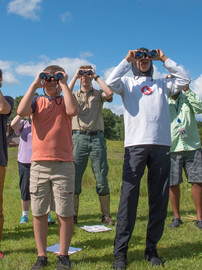
New to Birding?
Learn and get inspired: A Thing Called Birding and Birdwatch Close to Home.
Timing Is Everything
Poke your head out in the morning and evening when birds actively search for food to refuel for their night journey this coming fall.
Tools of the Trade
Use a binocular, spotting scope or telescope to help you see high-flying birds.
|

The more we see folks like ourselves outdoors, the more comfortable we will all be.
 Click on the photo for an MCV Q&A with leaders from the Urban Bird Collective.
I love birding year-round. I love birding alone and birding with friends. Or leading a group. I love going to a park to look for a specific species and spotting other species. I love to challenge myself to photograph at least 200 different bird species every year in Minnesota. I love using my photography to "bring" the birds to others to inspire them to get outside.
I love spending time in nature, as it helps relieve my day-to-day stress. I want other BIPOC (Black, Indigenous and people of color) to enjoy the same privilege. But BIPOC folks don’t always feel welcome or safe outdoors. Being a Latina I know that feeling well.

Through the Urban Bird Collective I brought together BIPOC and LGBTQ (lesbian, gay, bisexual, transgender, queer) folks to create a safe space in nature to learn about birds, flowers, trees, amphibians and so much more.
I use our public lands because they are welcoming habitats for birds. I feel lucky to have access to all our amazing public spaces in Minnesota. On top of all my favorite places, each year I make a point of visiting at least four new places — and I'm always amazed. BIPOC folks need to be seen and claim space that is meant for everyone. I encourage them to connect with organizations that support BIPOC folks in learning new outdoor skills.
|
|